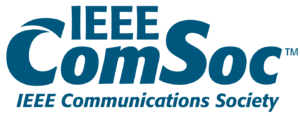(Click here to download CFP in PDF format)
Submission Instructions:
WD 2021 solicits original, unpublished work not currently under review by other conferences or journals. Papers submitted to WD 2021 will be assessed based on originality, technical soundness, clarity and interest to a wide audience. All submissions must be written in English and must use standard IEEE two-column conference template, available for download from the IEEE website: https://www.ieee.org/conferences/publishing/templates.html
Only PDF files will be accepted for the review process and all submissions must be done electronically through EDAS using the following link: https://edas.info/N27994
Technical papers can be of two types: full papers or short papers, up to 8 pages and 5 pages respectively, including tables, figures and references. Posters & Demo papers of length of 3 pages are also solicited.
Wireless Days 2021 is technically co-sponsored by IEEE, IEEE ComSoc
All accepted & presented papers will be published in IEEE Xplore
The best technical papers presented at the conference will be invited to submit an extended version for fast-track review in the following journals:
- IEEE Access Special Section on Collaborative Intelligence for Internet of Vehicles
- Annals of Telecommunications (Springer, ISI-indexed)
At least one author is required to register, at the full rate, to present accepted papers at the conference and for the paper to appear in the conference proceedings.
The 2021 Wireless Days conference program will be split into the following tracks:
Track 1: Ad hoc and Sensor Networking
Research in Mobile Ad-hoc NETworks (MANET) and Wireless Sensor Networks (WSN) has witnessed a renewed interest with the ever-increasing investment in many applicative contexts such as smart cities, intelligent transport systems, ambient assisted living, Internet of Things, and other wireless pervasive applications. These two technologies’ novel applications introduced new challenges that have not been addressed in the literature before, such as large-scale, long-range, and low-power communication technologies, lightly protocols to support security and robustness. The new applications combined with the significantly improved hardware capabilities require the research community to revisit the specifications of the challenges addressed in this research area and reassess the suitability and validity of the proposed solutions in the literature.
Main Topics of Interest
In this track, we solicit contributions from researchers and practitioners that focus on the practical implementation of MANET and WSN applications. We invite submissions of unpublished and original research in all aspects of WSN, ad-hoc networks and MANET technologies. Topics of interest includes, but not limited to, the following topics:
- Low-power routing protocols
- MAC protocols and scheduling mechanisms
- Machine-to-Machine (M2M) communications and applications
- Adaptive radio resource management in wireless networks
- Autonomous optimisation techniques for QoS support
- Self-organization, management and network reconfiguration
- Security, privacy and trust
- Modelling, simulation, implementation, testbeds and prototypes MANET and WSN
- WSN for healthcare, ecology, emergency, military, agriculture, etc. applications
- Wireless mesh networks
- Vehicular ad-hoc networks
- Underwater and air sensor networks
- Flying ad-hoc networks (FANETs)
- Cognitive Ad Hoc Networks
- MANET with energy harvesting
- Green Network Techniques applied to MANET
- Transport protocol in WSN and MANET
- Cross layering techniques applied in MANET and WSN
- Multimedia in MANET and WSN
Track 2: Connected & Autonomous Vehicles in Land, Water, and Sky
The shape of smart mobility is changing, driven by research in three directions: first, the incorporation of underwater vehicles and unmanned aerial vehicles into holistic vehicular communication systems. Second, the incorporation of new technologies for communication over the air – such as the 11p extensions nicknamed “802.11px”, along with entirely new 3GPP operation modes for cellular vehicle-to-everything communication (C-V2X) and complemented by novel wireless communication modes of vehicular visible light communication (V-VLC). Third, the incorporation of fundamental changes in system design prompted by new multi-radio, multi-technology, multi-system communication approaches, new service provision models, and improvements in the performance evaluation of system designs.
The purpose of this track is to bring together researchers, engineers, and students from academia and industry to discuss and exchange novel ideas about theoretical and practical aspects in the application domains of intelligent road transportation systems, unmanned aerial vehicles, and underwater wireless networks.
Main Topics of Interest
We solicit original and unpublished work in the area of Connected & Autonomous Vehicles in Land, Water and Sky, including but not limited to the following topics of interest:
- Communication technologies in the air (WLAN, C-V2X, V-VLC, and beyond)
- Communication technologies under water
- Medium access and spectrum sharing
- Novel networking concepts
- Use cases and applications
- Multi-radio, Multi-technology, Multi-system Vehicular Communications
- Service provision
- Interactions with other systems
- Simulative performance evaluation
- Field operational tests and practical experience
- Electric Vehicles, and Intelligent Transportation
- Vehicle Cooperation and Control, Assisted and Autonomous Driving
- Vehicular Edge Computing and Networking
Track 3: IoT and smart X: Networking, Cloudification, and Services
The Internet of Things (IoT) is penetrating and transforming our lives. Sensing and identification technologies embedded in everyday objects, together with local and wide-area communication and computation systems (both in the environment and in the Cloud), enable us to gain impressive awareness about the real world’s state and will drastically change the way we interact with our environment. Urban planning, smart cities, intelligent shopping, smart meters, home automation, security and surveillance, industrial applications like process industry automation, supply chain, smart product management, and agricultural applications are examples of potential real-world systems applications. Even though the advent of the IPv6/6LoWPAN protocol suite solved several technical issues, many challenges are still open in the research and development communities concerning the choice of communication paradigms, architectures, and technology.
The next step in the IoT evolution is its characterization as the underlying technological layer needed to shape and substantiate higher-layer concepts like the semantic web and personalization. The IoT is the enabling technology to allow the virtual and physical world to converge in what has already been defined as Web 3.0. If currently, the IoT is the most suited companion of blogging, podcasting, tagging, and social networking, we can imagine that its evolution will foster the rise of statistical, machine-constructed semantic tags and algorithms through the construction and exploitation of semantic databases empowered by distributed and cloud computing. The integration of the IoT with semantic databases, capable of delivering accurate information about the nature and the state of every physical object, will introduce a staggering amount of new application opportunities and potentially lead to an ultimate “Big brother scenario.” Therefore, particular interest will have to be given to appropriate security and privacy control mechanisms.
Main Topics of Interest
This track aims to bring together researchers and practitioners in the area of IoT and discuss the current state and future directions of the field. Topics of particular interest include, but are not limited to:
- IoT paradigms, architectures, applications and technologies
- IoT for semantic web and personalization
- Methodologies and tools for developing IoT applications
- Blogging, Podcasting, Tagging and Social networking through the IoT
- Cloud vs distributed computing for the IoT
- IoT system architectures, including peer-based architectures, Edge/Fog computing
- Reconfigurable computing for IoT
- Security and privacy for IoT systems and devices
- IoT data models and update protocols
- Adaptive IoT systems and services
- IoT applications, use cases and deployments
Track 4: Wireless and Mobile Communications: 5G, 6G, Wifi-ng, and beyond
The proliferation of high-end mobile devices as well as the increasing popularity of multimedia-based applications has led to an exponential increase in the data traffic. This explosion of mobile broadband traffic puts significant pressure on the underlying mobile networks technologies. While the initial technologies lacked flexibility due to their hardware proximity and dependence, current (5G) and future (6G, Wifi-ng, etc.) wireless systems promise the advent of a new era. This promise comes with high expectations of ultra low latency and record-breaking data speeds to accommodate applications with strict Quality of Service (QoS) requirements. Consequently, the network operators will have to overcome the challenges of accommodating all these heterogeneous bandwidth-hungry applications while maintaining high levels of Quality of Experience (QoE) for their customers. However, looking at the current environment, it is becoming apparent that these high expectations cannot be reached with just a simple increase in the system capacity without rethinking the entire network architecture and integrating new emerging technologies.
The aim of this track is to bring together experts from industry, academia and regulatory bodies and to offer a deep understanding of the challenges faced by next generation wireless and mobile communications and its applications with possible solutions.
- Antennas, smart antennas, and space-time processing
- Device-to-device and machine-to-machine communications
- Distributed, relay assisted, and cooperative communications
- Energy efficient PHY layer design, energy harvesting
- Heterogeneous and small-cell networks
- Hybrid communication systems (e.g. satellite/terrestrial/wireline hybrids)
- Information-theoretic aspects of wireless communications
- Interference modelling, management, cancellation, and alignment
- MIMO, multi-user MIMO, and massive MIMO
- Modulation, coding, diversity, equalization, synchronization
- Multiple access techniques and air interfaces (CDMA, TDMA, FDMA, OFDMA)
- Next generation and beyond multiple access techniques (NOMA, SCMA, MUST, etc.)
- OFDM and multi-carrier systems
- Physical-layer network coding
- Signal processing for wireless communications
- Ultra-wideband, mmWave, and sub-THz communications
- Underwater communications
- Wireless network coding
- Visible Light communication
- Emerging Wireless Protocols and Applications
- QoS and QoE Provisioning over Wireless Multimedia Networks
- Energy Efficiency for Wireless Multimedia Networks
- Cross-layer Optimization for Multimedia Service Support
- Multimedia Streaming Adaptation Techniques
- Green Communications and Networking
- Mobility and Portability in Future Mobile Networks
- Optimizations in Centralized-RAN and Cloud-RAN Architectures
- Content-Centric Networking: caching, naming, distribution, load balancing, resiliency
- Radio Resource Allocation and Scheduling
- Mobility, Handoff, and Location Management
- Network Virtualisation
- Experimental Test-beds and Performance Evaluation
- Low Power Local and Wide Area Networking
Track 5: Wireless Models and Simulations
The complexity of wireless systems is escalating. Interactions among increasing numbers of radio technologies in the presence of growing capacity demands, strong QoS requirements, large numbers of devices, high mobility, and energy constraints entail challenging problems at all wireless network layers. The investigation of these problems involves the development of novel analytical models of wireless systems, as well as original wireless network simulation tools that are realistic and allow for credible, verifiable, and reproducible results.
This track aims to provide an international technical forum to bring together experts from industry and academia from across the world, to discuss and present new ideas and research results on subjects related to wireless models and simulations.
Main Topics of Interest
Topics of interest include, but are not limited to:
- Performance evaluation of wireless systems through modeling and simulation
- Formal methods for the analysis of wireless systems
- Analytical models of wireless systems
- Wireless network optimization
- Characterization of communication channels
- Simulation of wireless networks
- Verifiability and reproducibility of wireless network simulations
- Design and evaluation of wireless protocols and algorithms
- Mobility management in wireless systems
- Analysis of capacity, coverage, connectivity and efficiency in wireless systems
- Load balancing of wireless systems
- Scalability and manageability of network architectures
- Measurements and experiments in wireless systems
Track 6: AI for Wireless and Mobile Networks
TBA
Track 7: Wireless and mobile networking technologies for fighting pandemics (Special Track)
- Sensing solutions for Healthcare automation systems
- contact tracing, tracking and monitoring
- Communications technologies virtual education and conferencing
- Industry and supply chain automation
- Communications technologies for Telemedecin
- Remote healthcare systems
- Security, Privacy, and Trust
- Pervasive Connectivity






